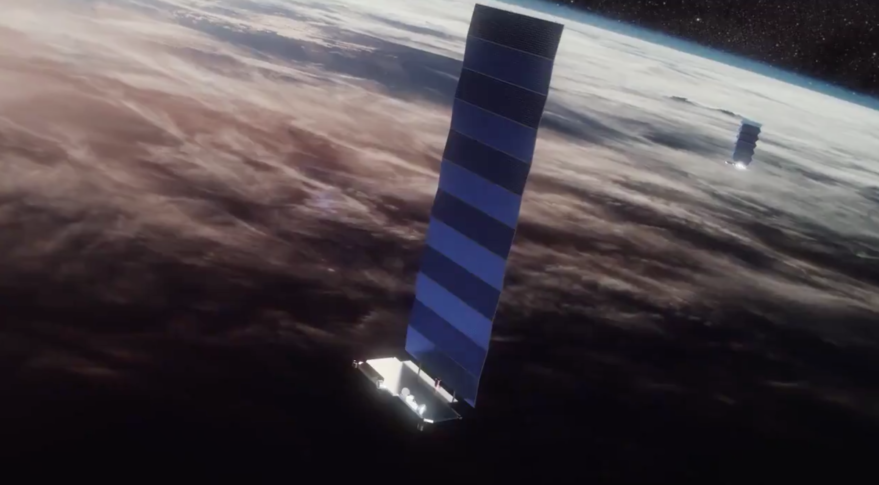
This article is from a series on educational technology in space technology .
Starlink - SpaceX's plan to distribute the Internet through tens of thousands of satellites is the main theme in the space press. Articles about the latest achievements are published weekly. If, in general, the scheme is clear, but after reading the reports in the Federal Communications Commission , a well-motivated person (say, your humble servant) can accumulate a lot of details. However, there are still many misconceptions associated with this new technology, even among enlightened observers. Often there are articles in which Starlink is compared with OneWeb and Kuiper (among others) as if they are competing on an equal footing. Other authors, clearly preoccupied with the good of the planet, shout about space debris, space law, the standards and safety of astronomy. I hope that after reading this rather long article, the reader will better understand and imbue the idea of Starlink.

The previous article unexpectedly touched a sensitive thread in the souls of my few readers. In it, I explained how Starship will lead SpaceX into the lead for a long time and at the same time provide a mechanism for new space exploration. The subtext is that the traditional satellite industry is unable to keep up with SpaceX, which is steadily increasing its power and reducing the cost of the Falcon rocket family, putting SpaceX in a difficult position. On the one hand, it formed a market worth, at best, several billion a year. On the other hand, it inflamed an indefatigable appetite for money - to build a huge rocket, on which, however, there was almost no one to send to Mars, and there was no reason to wait for immediate profit.
The solution to this pairing problem is Starlink. By assembling and launching its own satellites, SpaceX would be able to create and define a new market for highly efficient and democratized access to communications through space, provide an influx of finance for building a rocket before it drowned the company, and increase its economic value to trillions. Do not underestimate the scope of Ilon’s ambitions. In total, there are not so many industries where trillions of dollars revolve: energy, high-speed transport, communications, IT, healthcare, agriculture, government, defense. Despite common misconceptions, space drilling , moon water production and space solar panels are not viable businesses. Ilon invaded the energy sector with his Tesla, but only telecommunications will provide a reliable and capacious market for satellites and rocket launches.

For the first time, Elon Musk turned his gaze toward space, when he wanted to invest $ 80 million in a mission to grow plants on a Martian probe without a trace. The construction of a city on Mars will probably cost 100,000 times more, so Starlink is Mask’s main bet on providing a sea of money, which is so necessary for sponsoring an autonomous city on Mars .
For what?
I had been planning this article a long time ago, but only last week I had a complete picture. Then SpaceX president Gwynn Shotwell gave Rob Baron a terrific interview, which he then highlighted for CNBC on Michael Schitz, an excellent Twitter thread , to which several articles have been dedicated. This interview showed a huge difference in the approaches to satellite communications between SpaceX and everyone else.
The Starlink concept was born in 2012, when SpaceX realized that their customers - mainly satellite service providers - had huge amounts of money. Launch pads break prices for the deployment of satellites and at the same time, in a way, miss one stage of work - how so? Ilon dreamed of creating a satellite constellation for the Internet and, unable to resist the almost impossible task, spun the process. The development of Starlink was not without difficulties , but by the end of this article you, my reader, will probably be surprised how really these difficulties are small - given the scope of the idea.
Is such a huge grouping necessary for the Internet at all? And why now?
Only in my memory did the Internet turn from purely academic pampering into the first and only revolutionary infrastructure. This is not a topic that a detailed article should be devoted to, but I will assume that globally the need for the Internet and the income it brings will continue to grow by about 25% per year.
Today, almost all of us get the Internet from a small number of geographically isolated monopolies. In the USA, AT&T, Time Warner, Comcast, and a handful of smaller players divided the territory to avoid competition, tearing for services in three skins and basking in the rays of almost universal hatred.
For non-competitive behavior, providers have a good reason - in addition to all-consuming greed. Building infrastructure for the Internet — microwave cell towers and fiber optics — is very, very expensive. The wonderful nature of the Internet is easy to forget. My grandmother first went to work in World War II as a signalman, and the telegraph then competed for a leading strategic role with carrier pigeons! For most of us, the information superhighway is something ephemeral, intangible, but bits travel through the physical world, in which there are borders, rivers, mountains, oceans, storms, natural disasters and other obstacles. Back in 1996, when the first fiber optic line was laid across the ocean floor, Neil Stevenson wrote an exhaustive essay on cyber tourism . With his signature sharp style, he vividly describes the bare cost and complexity of laying these lines, along which then cursed “cottages” still rush about. For most of the 2000s, cables were pulled so much that the deployment cost was astounding.
At one time, I worked in an optical laboratory and (if memory serves), we broke the record of that time by issuing a multiplex transmission speed of 500 Gb / s. Limitations in electronics allowed each fiber to be loaded at 0.1% of theoretical throughput. Fifteen years later, we are ready to exceed the threshold: if the data transfer goes beyond it, the fiber will melt, and we are already very close to this.
And it is necessary to raise the data stream above the sinful earth - into space, where in five years the satellite freely flies around the “ball” 30,000 times. An obvious, it would seem, solution - so why didn’t anyone take it before?
The Iridium satellite constellation, developed and deployed by Motorola in the early 1990s (still remember them?), Became the first global low-orbit communications network (as it is tempting to describe in this book ). By the time it was deployed, the niche ability to route small packets of data from asset trackers turned out to be its only use: cell phones became so cheaper that satellite phones did not enter. Iridium had 66 satellites (plus a few more spare ones) in 6 orbits - the minimum set to cover the entire planet.
If Iridium had 66 satellites, then why SpaceX tens of thousands? How is she so different?
SpaceX entered this business from the opposite end - it started with launches. She became a pioneer in the field of preservation of the launch vehicle and thus took possession of the market for cheap launch pads. Attempts to interrupt their offer at a lower price will not bring a lot of money, so the only way to somehow weld on their excess capacity is to become their client. The cost of SpaceX to launch its own satellites is one tenth of the cost (per 1 kg) of Iridium, and therefore they are able to enter a much wider market.
Starlink's worldwide reach will provide you with high-quality internet access anywhere in the world. For the first time, Internet access will depend not on the proximity of a country or city to the fiber line, but on the purity of the sky above your head. Users all over the world will have access to the free from the shackles of the global Internet, regardless of their own, in varying degrees, bad and / or dishonest government monopolies. Starlink's ability to break these monopolies catalyzes incredible, scaled-up positive changes that will finally bring billions of people together into the global cyber community of the future.
A little lyrical digression: what does this even mean?
For people today, in an era of ubiquitous connectivity, the Internet is like the air we breathe. He just is. But this - if you forget about his incredible power to bring positive changes - and we are already in their very center. With the help of the Internet, people can call their leaders to account, communicate with other people on the other side of the world, share their thoughts, invent something new. The Internet unites humanity. The history of modernization is the history of the development of data exchange capabilities. First, through speeches and epic poetry. Then - on a letter that gives a voice to the dead, and they turn to the living; writing allows you to store data and makes asynchronous communication possible. The print press has put news production on stream. Electronic communication - accelerated data transfer around the world. Personal devices for storing notes gradually became more complex, evolving from notebooks to cell phones, each of which is a computer connected to the Internet, stuffed with sensors and every day better predicting our needs.
A person who uses writing and a computer in the process of cognition is more likely to overcome the limitations of an imperfectly developed brain. Even more encouraging is that cell phones are both powerful data storage devices and a mechanism for exchanging ideas. If earlier people, sharing their thoughts, relied on the speech that was scribbled in notebooks, today it’s the norm - if notebooks themselves share ideas that people generated. The traditional scheme has undergone inversion. The logical continuation of the process is a form of collective metacognition, through personal devices that are even more tightly integrated into our brain and connected to each other. And even though we are still nostalgic for the lost connection with nature and solitude, it is important to remember that technology and only technology is responsible for the lion's share of our liberation from the “natural” cycles of ignorance, premature death (which can be avoided), violence, hunger and tooth decay.
How?
Let's talk about the business model and architecture of the Starlink project.
For Starlink to become a profitable enterprise, the inflow of funds must exceed the cost of construction and operation. Traditionally, investment involves increased upfront costs, the use of sophisticated specialized financing and insurance mechanisms - all to launch a satellite. A geostationary communications satellite can cost $ 500 million, and assembly and launch can take 5 years. Therefore, companies in this area are simultaneously building jet ships or container ships. Gigantic spending, an inflow of funds that barely covers financing costs, and a relatively small operating budget. Conversely, the collapse of the original Iridium was that Motorola forced the operator to pay deadly license fees, bankrupt the company in just a few months.
To conduct such a business, traditional satellite companies had to serve private customers and charge high data transfer rates. Airlines, remote outposts, ships, war zones and key infrastructure facilities pay about $ 5 per 1 MB, which is 5,000 times more expensive than traditional ADSL communications, despite the delay in data transfer and the relatively low satellite bandwidth.
Starlink plans to compete with terrestrial service providers, which means it will have to deliver data cheaper and, ideally, take much less than $ 1 per 1 MB. Is this possible? Or, if this is possible, one should ask: how is this possible?
The first ingredient in the new dish is a cheap launch. Today, Falcon sells a launch of 24 tons for about $ 60 million, which is $ 2,500 per 1 kg. It turns out, however, far more internal costs. Starlink satellites will be launched on reusable launch vehicles, so the marginal cost of a single launch is the cost of a new second stage (somewhere around $ 4 million), fairings (1 million) and ground handling (~ 1 million). Total: somewhere around 100 thousand dollars per satellite, i.e. more than 1000 times cheaper than launching a conventional communications satellite.
Most Starlink satellites, however, will be launched on Starship. Indeed, the evolution of Starlink, as updated reports from the FCC show, provides some insight into how, as the Starship idea came to fruition, the internal architecture of the project developed . The total number of satellites in the constellation increased from 1,584 to 2,825, then to 7,518 and, finally, to 30,000. According to gross accumulations, the figure is even higher. The minimum number of satellites for the first stage of development for a project to be viable is 60 pieces in 6 orbits (360 in total), while 24 orbits of 60 satellites (1440 in total) are required for full coverage within 53 degrees from the equator. This is 24 launches for Falcon for some $ 150 million in domestic costs. Starship is designed to launch up to 400 satellites at a time, at about the same price. Starlink satellites will be replaced every 5 years, so 6,000 satellites will require 15 Starship launches per year. It will cost some 100 million / year, or 15 thousand / satellite. Each satellite displayed on the Falcon weighs 227 kg; satellites raised on Starship could weigh 320 kg and carry third-party devices, be slightly larger and at the same time not exceed the permissible load.
What is the cost of satellites made up of? Among the brethren, Starlink satellites are somewhat unusual. They are assembled, stored and launched in a flat form and are therefore extremely simple in mass production. As experience shows, the production cost should roughly equal the cost of the launcher. If the price difference is large, then resources are allocated incorrectly, since a comprehensive reduction in marginal costs while lowering costs is not so great. Is it really 100 thousand dollars per satellite for the first batch of several hundred - is this real? In other words, is the Starlink satellite in the device no more complex than a machine?
To fully answer this question, you need to understand why the cost of an orbital communication satellite is 1000 times higher, even if it is not 1000 times more complicated. To put it simply, with what joy is the space “iron” so expensive? There are many reasons for this, but the most compelling in this case is this: if launching a satellite into orbit (before Falcon) costs more than 100 million, it should be guaranteed to work for many years - in order to bring at least some profit. To ensure such reliability in the operation of the first and only product is a painful process and can drag on for years, requiring the efforts of hundreds of people. Add to this the costs, and now it’s easy to justify additional processes, since the launch is already expensive.
Starlink breaks this paradigm by creating hundreds of satellites, quickly correcting early design flaws and using mass-production techniques to manage costs. It’s easy for me personally to imagine the Starlink conveyor, on which the technician integrates something new into the structure and fastens everything with a plastic screed (NASA level, of course) in an hour or two, maintaining the required replacement level of 16 satellites / day. The Starlink satellite consists of many tricky details, but I don’t see the reasons why by the thousandth unit coming off the assembly line, its cost can not be lowered to 20 thousand. Indeed, in May, Ilon wrote on Twitter that the cost of producing a satellite is already lower than the cost of launch .
Take the average case and analyze the payback time by rounding the numbers. One Starlink satellite, which costs 100 thousand to assemble and launch, has been operating for 5 years. Will he pay for himself, and if so, how soon?
For 5 years, the Starlink satellite will fly around the Earth 30,000 times. In each of these one and a half hour rounds, he will spend most of the time over the ocean and, probably, 100 seconds over a densely populated city. In this short window, he broadcasts data in a hurry to earn money. If we assume that the antenna supports 100 beams, and each beam transmits 100 Mb / s using a modern coding such as 4096QAM , then the satellite generates $ 1,000 profit per revolution - at a subscription price of $ 1 per 1 GB. This is enough to pay back the deployment cost of 100 thousand in a week and greatly simplifies the capital structure. The remaining 29,900 turns are profit, net of fixed costs.
Estimated figures can vary greatly, and in both directions. But in any case, if you are able to launch a low-quality satellite constellation for 100,000 - or even for 1 million / unit - this is a serious request. Even taking into account the ridiculously short time of use, the Starlink satellite is capable of delivering 30 Pb of data during its operational life - at an amortized cost of $ 0.003 per 1 GB. At the same time, when transferring to longer distances, the marginal costs practically do not increase.
To understand the significance of this model, let's quickly compare it with two other models of delivering data to consumers: the traditional one is fiber optic cable, and the satellite constellation offered by a company that does not specialize in satellite launches.
SEA-WE-ME, a large submarine Internet cable connecting France and Singapore, was commissioned in 2005. Throughput - 1.28 Tb / s, deployment cost - $ 500 million. If it will operate at 100% capacity for 10 years, and overhead costs will be 100% of capital costs, then the transfer price will be $ 0.02 per 1 GB. Transatlantic cables are shorter and slightly cheaper, but submarine cable is just one thing in a long chain of people who want money for data transfer. The average rating for Starlink is 8 times cheaper, and at the same time they have all-inclusive.
How is this possible? The Starlink satellite includes all the sophisticated stuffing for electronic switching, which is necessary for connecting fiber optic cables, only for data transmission a vacuum is used instead of an expensive and brittle wire. Transmission through outer space reduces the number of cozy and obsolete monopolies, allowing users to communicate using even less iron.
Compare with the competing OneWeb satellite developer. OneWeb plans to create a constellation of 600 satellites, which it will launch through commercial suppliers at a price of about $ 20,000 per 1 kg. The weight of one satellite is 150 kg, that is, in an ideal situation, the launch of one unit will be approximately 3 million. The cost of satellite “iron” is estimated at 1 million per satellite, i.e. By 2027, the cost of the entire group will be 2.6 billion. The tests that OneWeb conducted showed a bandwidth of 50 Mb / s. at the peak, ideally, on each of the 16 rays. Following the same scheme by which we calculated the cost of Starlink, we get: each OneWeb satellite generates $ 80 per revolution, and in just 5 years it will bring 2.4 million - barely covering the cost of launch, if you also consider data transfer to remote regions . Total we receive 1.70 dollars for 1 GB.
Gwynn Shortwell recently quoted the words that Starlink is supposedly 17 times cheaper and faster than OneWeb , which implies a competitive price of $ 0.10 per 1 GB. And this is even with the initial configuration of Starlink: with less optimized production, launch on Falcon and restrictions in data transfer - and only with coverage in the north of the USA. It turns out that SpaceX has an undeniable advantage: today they can launch a much more suitable satellite at a price (per unit) of 15 times lower than that of competitors. Starship will increase the gap by 100 times, if not more, so it’s easy to imagine how, by 2027, SpaceX will launch 30,000 satellites for less than $ 1 billion, most of which it will provide from its own wallet.
I’m sure there are more optimistic analyzes regarding OneWeb and other promising developers of satellite groups, but I don’t yet know how they work.
Morgan Stanley recently estimated that Starlink satellites would cost $ 1 million per assembly and $ 830 thousand per launch. Gwynn Shotwell, answered: he de "gave such a foolish blow . " Curiously, the numbers are similar to our estimates for OneWeb costs, and roughly 10 times higher than the original Starlink version. The use of Starship and the industrial production of satellites can reduce the cost of deploying satellites to about 35 thousand / unit. And this is a strikingly low figure.
The last point remains - to compare the profit per 1 W of solar energy generated for Starlink. According to the photos on their website, each satellite’s solar battery has an area of approximately 60 square meters, i.e. On average, it generates approximately 3 kW or 4.5 kW / h per revolution. According to a rough estimate, each turn will produce $ 1,000, and each satellite will generate approximately $ 220 per kWh. This is 10,000 times the wholesale cost of solar energy, which once again confirms: to extract solar energy in space is a hopeless enterprise . And the modulation of microwaves for data transmission is exorbitant added value.
Architecture
In the previous section, I rather roughly described the non-trivially significant part of Starlink architecture - how it works with extremely uneven population density on the planet. The Starlink satellite emits focused beams that form spots on the surface of the planet. Subscribers within the spot share the same bandwidth. The spot dimensions are determined by fundamental physics: initially its width is (satellite height x microwave length / antenna diameter), which for the Starlink satellite, at best, is a couple of kilometers.
In most cities, the population density is about 1000 people / sq. Km, although in some places it is higher. In some areas of Tokyo or Manhattan, more than 100,000 people can be stained. Fortunately, in any such densely populated city, there is a competitive domestic broadband Internet market, not to mention a highly developed network of mobile phones. But be that as it may, if at any given time over the city there are many satellites of the same constellation, the throughput can be increased by spatial diversity of the antennas, as well as by frequency distribution. In other words, dozens of satellites can focus the most powerful beam at one point, and users in this region will use ground terminals that will distribute the request between the satellites.
If at the initial stages the most suitable market for services is remote, rural or suburban areas, then funds for further launches will come from better services to densely populated cities. The scenario is the exact opposite of the standard market expansion scheme, in which competitive city-oriented services inevitably suffer a decline in profits as they attempt to expand toward poorer and less populated areas.
A few years ago, when I made the calculations, it was the best map of population density .
I took the data from this image and compiled 3 graphs below. The first shows the frequency of the earth’s area by population density. The most interesting thing is that most of the Earth is not populated at all, while in almost no region there are more than 100 people / sq. Km.

The second graph shows the frequency of people by population density. And although most of the planet is not populated, the majority of people live in areas where there are 100-1000 people per sq km. The expanded nature of this peak (an order of magnitude greater) reflects bimodality in urbanization schemes. 100 people / sq. Km. - This is a relatively poorly populated rural area, while the figure is 1000 people / sq. Km. already characteristic of the suburbs. City centers easily show 10,000 people / sq. Km, but the population of Manhattan is 25,000 people / sq. Km.

The third graph shows the population density by latitude. It can be seen that almost all people are concentrated in the range of 20–40 degrees north latitude. So, by and large, it happened geographically and historically, since the ocean occupies a huge part of the southern hemisphere. Nevertheless, such a population density is a frightening challenge for the architects of the group, because in both hemispheres, satellites spend an equal amount of time. , , , , , 50 , . Starlink 6 , — 24.

, , . SpaceX . , — , , , . , — , !

, ? Starlink . « ». Starlink . , . , , « » . , , SpaceX .
, – — , . 11 . , , , , . /., , , , .
— - , , , , . , « ».
— — , . : . , , — , , . This is the so-called « » , , 2015- « ».
— , , , , Starlink. 4500 , , . . , ( ) , . , .

, . , , . , , .
30 000 11 , ! , , .


, , . : , , — ? SpaceX , , , Starship .
, . - Starlink (330 ) . , 300 — , , Krypton, . , , 160 , SpaceX , .
, - 35 ., , Starship , , . 80 /. ( 100 , 100 /).
- (1+SNR). , SNR — , . — . FPGA Xilinx Ultrascale+ GTM- 58 /. , ASIC. 58 /. , - V-. V (40–75) , , .
100 ? : . , . — , (. 1), — . - — 1 , 0,01 — 50% . , 1 ( 50- ), 2500 . , 2500 2500 , , , , . !
2500 , 58 /., — — , 145 /. , - 2020 640 / . , . 30 000 2026 , - 800 /. ~500 , 800 /., 10 , , .. 10 .
330- , 0,01 10 .. 300 000 . Netflix (7 /. HD-)? 2000 /., 35 , - . , .
— , 35 . 1 400 , 0,0002/., 100 000 — . , SpaceX 20–40 , 30 000 .
, , , . , . , — VLA ( )? : — , — . , , . (, ), — - . .
, — — .
Application
Starlink? , , - , .
, : IoT asset tracker' , .
Starlink . , « ».
, . — . Starlink — , — 50% , , .
. — , . - , . , SpaceX .
, , . , -, , , , -, . , 50 . , . , , , — , - , , .
The problem with the status quo is that, unlike water, electricity, or gas, the Internet is still young and rapidly developing. We constantly find him a new application. The most revolutionary is still not open, but package plans choke the possibility of competition and innovation. Billions of people are left behind the digital revolution due to the circumstances of birth, or because their country is too far from the submarine cable trunk. Geostationary satellites still deliver Internet to large regions of the planet at a predatory price.
Starlink, which continuously distributes Internet from the sky, violates this model. I don’t know yet another better way to connect billions of people to the Internet. SpaceX is on its way to becoming an Internet Service Provider and, potentially, an Internet company that competes with Google and Facebook. I bet you never thought of that.
The fact that satellite Internet is the best option is not obvious. SpaceX and only SpaceX are in a position to quickly create an extensive constellation of satellites, because only it killed a decade to break the government-military monopoly on the launch of spacecraft. Even if Iridium outstripped cell phones in the market tenfold, it would still not have been widely used using traditional pads. Without SpaceX and its unique business model, it is likely that the global satellite Internet will simply never happen.
The second major blow will be in astronomy. After the launch of the first 60 Starlink satellites, a wave of criticism began from the international astronomical community, saying that a significantly increased number of satellites would block their access to the night sky. There is a saying: among astronomers, the cooler one with the largest telescope. Without exaggeration, to engage in astronomy in the modern era is an architrual task, reminiscent of a continuous struggle to improve the quality of analysis against the background of growing light pollution and other noise sources.
Least of all, the astronomer needs thousands of bright satellites flickering in the focus of the telescope. Indeed, the first group of Iridium gained notoriety for giving "light" because of large panels that reflected sunlight on small areas of the Earth. It happened that they reached the brightness of a quarter of the moon and sometimes even accidentally damaged sensitive astronomical sensors. Fears are also unfounded that Starlink will invade the radio bands used in radio astronomy.
If you download the satellite tracking application, you can see dozens of satellites flying in the sky on a clear evening. Satellites are visible after sunset and before dawn, but only when they are illuminated by the sun's rays. Later, during the night, satellites are invisible in the shadow of the Earth. Tiny, extremely distant, they move very fast. There is a chance that they will obscure a distant star for less than a millisecond, but, I think, even detecting this is one more hemorrhoids.
Strong concern due to the flare of the sky was born because the layer of satellites of the first launch was built close to the Earth terminator, i.e. night after night, Europe - and it was summer - watched an epic picture of how satellites fly in the sky at evening twilight. Further, simulations based on reports in the FCC showed that satellites in orbit at 1,150 km will be visible even after astronomical twilight passes. In general, twilight goes through three stages: civil, marine and astronomical, i.e. when the sun is 6, 12 and 18 degrees below the horizon, respectively. At the end of astronomical twilight, the sun's rays are located about 650 km from the surface at the zenith, far beyond the atmosphere and most of the low Earth orbit. Based on data from the Starlink website , I believe that all satellites will be placed at an altitude below 600 km. In this case, they can be seen at dusk, but not after nightfall, which will significantly reduce the potential consequences for astronomy.
The third problem is orbital debris. In a previous post, I pointed out that satellites and debris below 600 km will leave their orbits within a few years - due to atmospheric resistance, greatly reducing the possibility of Kessler syndrome. SpaceX interfere with the mud, as if they did not think about space debris at all. Here I look at the details of the Starlink implementation, and it’s hard for me to imagine the best way to reduce the amount of garbage in orbit.
The satellites are displayed at an altitude of 350 km, then they fly off with their built-in engines to their intended orbit. Every satellite that died at launch will go out of orbit in a few weeks, and it will not be wound somewhere higher than the next thousand years. Such placement strategically involves testing for free entry. Further, Starlink satellites are flat in cross section, which means that, losing control of altitude, they enter dense layers of the atmosphere.
Few people know that SpaceX became a pioneer in astronautics, starting to use alternative types of mounts instead of squibs. Almost all launch pads use the squib when deploying steps, satellites, fairings, etc., etc., thereby increasing the potential amount of garbage. SpaceX also deliberately removes the upper steps from orbit, preventing them from hanging out in space forever, so that they do not deteriorate there and do not decay in a rigid space environment.
And finally, the last problem that I would like to mention is the chance that SpaceX will supersede the existing monopoly on the Internet, creating its own. In its niche, SpaceX has already monopolized launches. Only the desire of rival governments to get guaranteed access to space does not allow them to discard expensive and obsolete missiles, which are often assembled by large monopolistic defense contractors.
It’s not so difficult to imagine how in 2030 SpaceX will launch 6,000 of its satellites annually, plus several spy satellites - from an old memory. Cheap and reliable SpaceX satellites will begin to sell “rack-space” for third-party devices. Any university that has created a camera suitable for use in space will be able to put it into orbit, and it will not have to cover the costs of building an entire space platform. With such advanced and unlimited space access, Starlink is already associated with satellites, while historical manufacturers are a thing of the past.
There are examples of far-sighted companies in history that have occupied such a huge niche in the market that their names have become common nouns: Hoover, Westinghouse, Kleenex, Google, Frisbee, Xerox, Kodak, Motorola, IBM.
A problem may arise when a pioneer company engages in anti-competitive practices in order to maintain its market share, although this has often not been forbidden since President Reagan. SpaceX may retain Starlink's monopoly by forcing other developers of satellite groups to launch satellites on old Soviet rockets. Similar actions taken by the United Aircraft and Transportation company , coupled with fixing the price of mail, led it to collapse in 1934. Fortunately, SpaceX is unlikely to forever maintain an absolute monopoly on reusable rockets.
Even more worrying is the fact that the deployment of SpaceX of tens of thousands of satellites in low orbit can be designed as co-optation of the public domain. A private company, pursuing personal gain, is gaining permanent ownership of once-generally accessible and unoccupied orbital positions. And although SpaceX's innovations made it possible to really make money in a vacuum, most of SpaceX's intellectual capital was built on billions of dollars allocated from the research budget.
On the one hand, laws are needed that protect private investment, research and development. Without this protection, innovators will not be able to finance ambitious projects or move their companies to where they will receive such protection. In any case, the public suffers because no profit is formed. On the other hand, we need laws that protect people, the nominal owners of the public domain, including heaven, from rent-seeking private entities that annex public goods. In itself, neither this nor that is true and not even possible. SpaceX developments give a chance to find a middle ground in this new market. We will understand that it is found when we maximize the frequency of innovation and the formation of social welfare.
Thoughts in the end
I wrote this article as soon as I completed another - about Starship . Hot stood out for a week. Both Starship and Starlink are revolutionary technologies that are created right before our eyes, in our lifetimes. If I see how my grandchildren grow up, they will be more amazed that I am older than Starlink, and not that in my childhood there were no cellular (museum exhibits) or the public Internet as such.
The wealthy and the military have long been using satellite Internet, but the ubiquitous, general and cheap Starlink without Starship is simply not possible.
They have been talking about the launch for a long time, but Starship, which is quite cheap and therefore an interesting platform, is impossible without Starlink.
They have been talking about manned astronautics for a long time, and if you are a pilot of a fighter jet, and at the same time a neurosurgeon , then you have a green light. With Starship and Starlink, space exploration by man is an achievable, near future, in which it is within easy reach from the orbital outpost to the industrialized cities in deep space.
